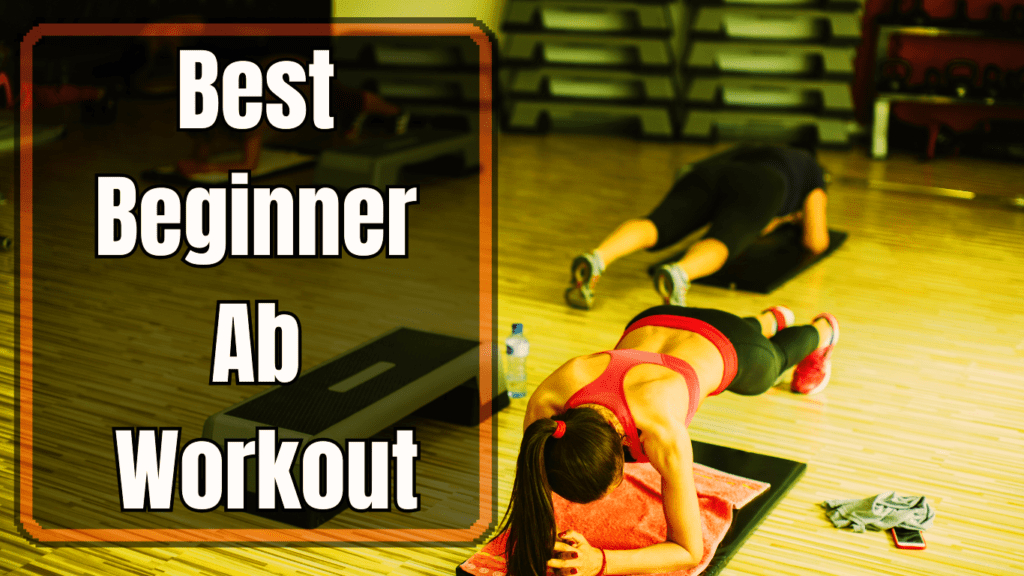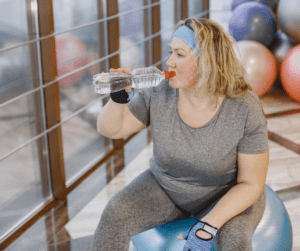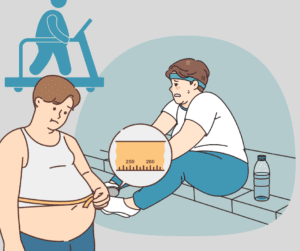Navigating the Beginner Ab Workout Maze for a Sculpted Midsection
Meet Dave, a charismatic 40-year-old on a mission to bid farewell to his stubborn belly fat. Determined to transform his physique, Dave embarks on a fitness journey by signing up for a gym membership. Having tried home ab workouts in the past without success, he is well aware that conquering his belly fat will be his biggest challenge.
As we delve into Dave’s story, it’s important to understand why individuals, especially those in their middle-aged glory, often find themselves grappling with persistent belly fat. Scientifically speaking, the aging process brings about changes in metabolism, leading to a tendency for the body to store more fat around the midsection. Hormonal shifts, a sedentary lifestyle, and poor dietary choices further contribute to the accumulation of abdominal fat.

Now, let’s shed light on the glimmer of hope for our friend Dave and others facing a similar struggle. The solution lies in the realm of the “beginner ab workout,” a path that promises to guide them to a sculpted midsection.
First and foremost, adopting a beginner mindset is crucial. It’s easy to be disheartened when witnessing gym regulars effortlessly executing advanced ab exercises. However, everyone starts somewhere, and celebrating small victories is key – whether that’s holding a plank for an extra 10 seconds or completing an entire set without collapsing.
Subscribe And Get Our Free E-Book:Unlocking The Power Of Nutrition-Supplements, Substitutes, and Superfoods!
Moving on, full-body workouts should take center stage in a beginner’s fitness routine. While sculpting abs is the ultimate goal, targeting only the abdominal muscles won’t yield optimal results. Incorporate exercises like squats, lunges, and push-ups that engage multiple muscle groups, accelerating overall fat loss and building a robust foundation for advanced ab workouts in the future.
Consistency becomes Dave’s mantra as he learns that regular exercise, rather than sporadic, intense workouts, is the key to burning calories and ensuring gradual, sustainable progress. This fitness journey, he realizes, is a marathon, not a sprint.
The beginner ab workout takes center stage in Dave’s routine. It involves exercises like crunches, leg raises, and bicycle crunches. Starting with a manageable number of repetitions, Dave gradually increases as his strength improves. He discovers that consistency and proper form outweigh the number of reps, emphasizing controlled movements, engaged core muscles, and mindful breathing.
As Dave progresses, he understands the integral role nutrition plays in revealing those hard-earned abs. No amount of crunches can outwork a poor diet. Whole foods, lean proteins, fruits, and vegetables become staples, while processed foods and sugary drinks take a backseat. Dave learns that abs are not just made in the gym but also in the kitchen.
There is hope for Dave and everyone navigating the maze of midsection struggles. A holistic approach, encompassing a beginner ab workout, full-body exercises, consistency, proper form, and a balanced diet, transforms the tunnel into a well-lit, scenic route toward a stronger, more defined core. Embracing the journey, enjoying the process, and letting those abs make their grand debut become the ultimate fitness triumph.
Ab Workouts for Success – A Guide for Beginners and Beyond
Now lets dive into the nuances of beginner ab workout, starting with exploring the differences between beginner and advanced routines. Let’s unravel the mysteries of sculpting abs, catering to various metabolic rates and age groups.
So, what sets apart a beginner ab workout from an advanced one? The answer lies in intensity and complexity. Beginners focus on foundational exercises like crunches, leg raises, and bicycle crunches, emphasizing proper form and controlled movements. On the other hand, advanced enthusiasts delve into intricate moves, incorporating stability challenges and resistance for a more sculpted core.
| Criteria | Beginner Ab Workouts | Advanced Ab Workouts |
|---|---|---|
| Intensity | Low to moderate | High |
| Complexity | Simple exercises with basic movements | Intricate exercises with advanced techniques |
| Focus | Foundation building | Muscle sculpting and refinement |
| Muscles Targeted | Mainly superficial muscles (e.g., rectus abdominis) | Deep core muscles and stabilizers (e.g., internal obliques) |
| Progression | Gradual increase in difficulty | Constant challenge and variation |
| Frequency | 2-3 sessions per week | 4-6 sessions per week |
| Duration | 15-30 minutes per session | 30-60 minutes per session |
| Recovery Time | Shorter recovery periods | Longer recovery periods |
| Equipment | Minimal equipment required | May require specialized equipment or accessories |
| Risk of Injury | Lower risk due to simpler movements | Higher risk due to complexity and intensity |
| Suitability | Ideal for beginners and those new to fitness | Suitable for experienced individuals with strong core |
Now, let’s address the burning question – how much ab workout is enough? For beginners with a slower metabolism, a couple of sessions per week suffices. Quality over quantity is key, focusing on building strength gradually. For those with a faster metabolism, a slightly higher frequency, around three to four times per week, is suitable. Consistency remains crucial for both types.
Middle-aged individuals might need to put in extra effort due to hormonal changes and a naturally slower metabolism. They should aim for a balance – not overdoing it but staying consistent with workouts. Core strength becomes pivotal for maintaining overall fitness and preventing age-related muscle loss.

When it comes to the duration of each exercise within a session, beginners should aim for 15-20 minutes, gradually increasing as endurance improves. It’s essential to listen to the body and avoid overexertion. As for the complexity of exercises, starting with basics is crucial to establish a strong foundation. However, as proficiency grows, incorporating more challenging moves can enhance progress.
Do ab exercises burn belly fat? While they strengthen and tone the muscles, targeted fat loss is a myth. To reveal those hard-earned abs, a combination of ab workouts and overall fat reduction through a calorie-controlled diet is necessary.
Now, let’s talk about cardio in a beginner ab workout. For individuals with a slower metabolism, incorporating 20-30 minutes of cardio, three times a week, enhances fat-burning. Those with a faster metabolism can opt for shorter, more intense sessions, around 15-20 minutes, a few times a week. Middle-aged individuals benefit from a balanced approach – not overly strenuous but consistent.
Is it okay to do abs every day? The answer depends on individual tolerance and recovery. Beginners should aim for 2-3 sessions per week, gradually increasing as strength improves. Advanced enthusiasts might include daily ab workouts, provided they vary intensity and allow for proper recovery.
Now, let’s dissect the role of diet in abs workouts. For those with a slower metabolism, a balanced diet with a slight calorie deficit aids fat loss. High-protein foods promote muscle growth. Individuals with a faster metabolism need to ensure they consume enough calories to support workouts and muscle development. Middle-aged individuals benefit from a diet rich in nutrients, supporting overall health and metabolism.
Sculpting enviable abs involves understanding individual needs. Beginners focus on building a foundation, with tailored workouts and gradual progression. Advanced enthusiasts incorporate complexity for a sculpted core. Middle-aged individuals strike a balance, emphasizing core strength. Cardio, exercise frequency, and diet play crucial roles, each tailored to individual metabolic rates and fitness levels. It’s not just about the abs; it’s about enjoying the journey to a healthier, fitter you.
The Ultimate Beginner Ab Workout Video
Beginner Ab Workout Breakdown
Now, let’s get to the core of the matter – the best ab exercises for beginners.
- Crunches:
- How to: Lie on your back, bend your knees, and place your hands behind your head. Lift your upper body towards your knees.
- Avoid: Pulling on your neck; focus on using your abdominal muscles.
- Leg Raises:
- How to: Lie flat on your back and lift your legs towards the ceiling, keeping them straight.
- Avoid: Arching your back; maintain contact with the floor.
- Bicycle Crunches:
- How to: Lie on your back, bring your knees towards your chest, and cycle your legs while twisting your torso.
- Avoid: Rushing through; focus on controlled, deliberate movements.
- Planks:
- How to: Support your body on your forearms and toes, maintaining a straight line from head to heels.
- Avoid: Sagging in the middle; engage your core muscles.
- Russian Twists:
- How to: Sit on the floor, lean back slightly, and twist your torso from side to side while holding a weight or keeping your hands together.
- Avoid: Over-rotating; keep movements controlled.
- Mountain Climbers:
- How to: Start in a plank position and bring your knees towards your chest alternately.
- Avoid: Hunching your back; maintain a strong plank position.
- Reverse Crunches:
- How to: Lie on your back, bring your knees towards your chest, lifting your hips off the ground.
- Avoid: Using momentum; focus on engaging your lower abs.
- Seated Russian Twists:
- How to: Sit on the floor, lean back, and twist your torso from side to side.
- Avoid: Rounding your back; keep it straight.
- Flutter Kicks:
- How to: Lie on your back, lift your legs slightly off the ground, and kick them up and down.
- Avoid: Lowering your legs too much; maintain tension in your abs.
- Side Planks:
- How to: Support your body on one forearm and the side of your foot, creating a straight line from head to heels.
- Avoid: Collapsing at the hips; engage your obliques.
Tips for Success:
- Proper Form: While the exercises are simple, maintaining proper form is essential to avoid injuries and maximize effectiveness. Pay attention to the instructions provided for each exercise.
- Starting Slow: Beginners should start with a manageable number of repetitions and sets, gradually increasing intensity as their strength and endurance improve.
- Listen to Your Body: If an exercise feels uncomfortable or causes pain (other than the typical muscle burn), it’s essential to modify or skip it. Everyone’s fitness level is different, and it’s crucial to progress at your own pace.
- Warm-Up: Prioritize a proper warm-up before starting your ab workout. This helps prepare the muscles and reduces the risk of injury.
Remember, consistency is key. It’s more important to perform the exercises correctly and gradually increase intensity than to rush through a workout. If you have any existing health conditions or concerns, it’s advisable to consult with a fitness professional or healthcare provider before starting a new exercise routine.

Tailored Beginner Ab Workout Plans for Every Pace Over 3 Months
In this segment, we’re about to embark on a personalized adventure – custom a beginner ab workout programs for various metabolic rates and middle-aged enthusiasts.
Program for Beginners with a Slow Metabolism:
Objective: Boost metabolism and gradually build core strength.
- Frequency: 3 sessions per week.
- Session Duration: 20-30 minutes.
- Warm-Up (5 minutes):
- Light cardio like brisk walking or cycling to increase heart rate.
- Main Ab Workout:
- Crunches: 3 sets of 12-15 reps.
- Leg Raises: 3 sets of 10-12 reps.
- Planks: 2 sets, hold for 30 seconds each.
- Reverse Crunches: 2 sets of 12 reps.
- Cardio Boost (5 minutes):
- Moderate-intensity cardio like jogging or jumping jacks.
- Cool Down (5 minutes):
- Gentle stretches for the core muscles.
Explanation: A slower metabolism benefits from a balanced approach, combining ab exercises with cardio to stimulate fat burn. The focus is on establishing a routine and gradually increasing intensity over the three months.
Program for Beginners with a Fast Metabolism:
Objective: Build lean muscle and enhance overall fitness.
- Frequency: 4 sessions per week.
- Session Duration: 30-40 minutes.
- Warm-Up (7 minutes):
- Dynamic stretches and light cardio to prepare the body.
- Main Ab Workout:
- Bicycle Crunches: 3 sets of 15 reps.
- Mountain Climbers: 3 sets of 20 reps.
- Russian Twists: 2 sets of 15 reps each side.
- Planks with Shoulder Taps: 2 sets, hold for 40 seconds.
- Cardio Boost (8 minutes):
- High-intensity cardio like sprinting or high knees.
- Cool Down (5 minutes):
- Deep stretches for flexibility.
Explanation: A faster metabolism benefits from a slightly more intense routine, incorporating dynamic movements and challenging exercises to maximize results over the three months.
Program for Middle-Aged Beginners:
Objective: Improve core strength, flexibility, and overall health.
- Frequency: 3 sessions per week.
- Session Duration: 25-35 minutes.
- Warm-Up (6 minutes):
- Gentle cardio and joint mobility exercises.
- Main Ab Workout:
- Seated Russian Twists: 3 sets of 12 reps each side.
- Flutter Kicks: 3 sets of 15 reps.
- Side Planks: 2 sets, hold for 25 seconds each side.
- Leg Raises with a Pelvic Tilt: 2 sets of 12 reps.
- Cardio Boost (7 minutes):
- Low-impact cardio like brisk walking or swimming.
- Cool Down (5 minutes):
- Yoga-inspired stretches for balance and flexibility.
Explanation: Middle-aged individuals benefit from a balanced program that emphasizes core strength, flexibility, and joint health. The routine focuses on foundational exercises with attention to form and controlled movements over the three months.
Adjusting the Numbers:
- Repetitions and Sets: Beginners should start with a number of repetitions that challenge them without compromising form – typically 10-15 reps. Gradually increase as strength improves. Aim for 2-3 sets initially, progressing to 3-4 sets.
- Progression: Every month, reassess your fitness level. If the workout feels too easy, consider increasing the intensity – more reps, added resistance, or advanced variations of exercises.
- Listen to Your Body: If an exercise feels uncomfortable or causes pain beyond the typical muscle burn, modify or skip it. Progress should be gradual and sustainable.
In conclusion, these personalized ab workout programs are designed to cater to the unique needs of beginners with varying metabolic rates and ages. Remember, consistency is key, and these programs aim to create a foundation for a healthier, fitter you over the next three months. So, lace up those sneakers, hit the mat, and let the journey to stronger, more defined abs continue!


